Original text: ZetaChain: The Path Forward for Universal Apps
By: Delphi Consulting
Compiled by: Odaily Planet Daily Husband
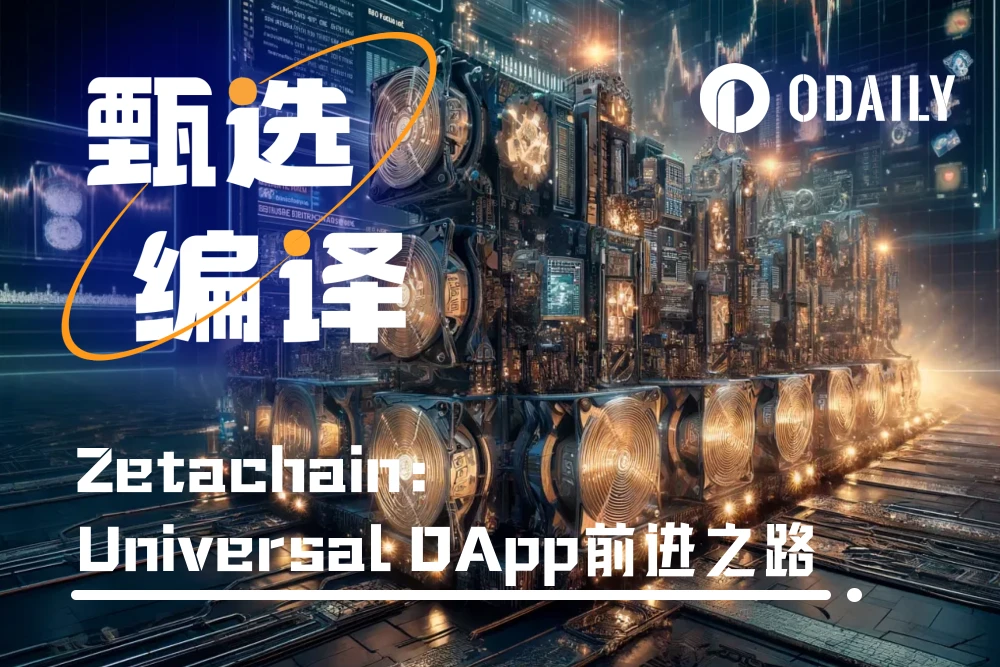
Due to the large number of words and dense technical content in this article, Odaily Planet Daily has refined the core points of the article to help readers understand the latest developments of ZetaChain as soon as possible.
In order to create an underlying foundation that is more in line with user experience, ZetaChain brings chain abstraction into Web3 and proposes a number of solutions. The specific points are as follows:
ZetaChain is a L1 blockchain based on the Cosmos SDK, designed for full-chain smart contracts and a unified application experience. It implements chain abstraction through the following layers of architecture:
Permission layer: handles accounts and permissions, and uses smart contract wallets and proxy services to simplify user interactions.
Solver layer: provides the best transaction path, automates the decision-making process, and reduces the users cognitive burden.
Settlement layer: Use cross-chain solutions such as bridges and oracles to ensure efficient completion of transactions.
ZetaChain’s main functions
Universal EVM: An improved Ethereum virtual machine that supports full-chain applications.
Cross-chain messaging: Allows developers to build full-chain applications that can call connected chains.
ZRC 20 standard: supports full-chain homogeneous tokens and simplifies cross-chain asset management.
TSS signer: Verifies the security of cross-chain transactions.
ZetaChain 2.0 Enhancements
Universal DApp: Supports calling contracts on connected chains from Universal DApp to achieve complex cross-chain interactions.
Full-chain account: Simplifies the process of users managing multiple blockchain assets.
Wider Bitcoin address compatibility: Supports more types of Bitcoin addresses.
New chain support: Add new chains through the governance process to expand network coverage.
Application Scenario
Native exchange: cross-chain asset exchange is realized, and users can complete complex cross-chain transactions with only one interaction.
Staking: Smart contracts stake ZETA tokens, simplifying the development of liquidity and re-staking applications.
NFT Applications: Support cross-chain NFT minting and transfer.
At the same time, ZetaChain is compared with other related solutions. Readers are advised to read this part in depth to better understand the advantages and disadvantages of different solutions. The author will not elaborate on it here. In short, ZetaChain simplifies the cross-chain interaction by automating and optimizing it. This improves the Web3 user experience, bringing it closer to the intuitive operation of Web2.
Introduction to Chain Abstraction
One of the main differences between Web3 and Web2 applications is their ease of use. In Web2, users are often unaware of the complexity that occurs behind the scenes. For example, when sending an email through Gmail, users simply type and click Just click “Send”. The system then handles server communication, data encryption, and spam filtering without any user intervention. Similarly, ordering food on UberEats involves seamless integration of restaurant menus, payment gateways, and delivery tracking. This is similar to payment Same for systems, messaging services, etc. All these underlying complex technologies are abstracted away from the user.
In fact, apps take it a step further by adding automated processes on top. Netflix not only abstracts the underlying technology, but also deliberately starts the next episode without the viewer pressing a button. These apps are in the business of extending the duration of the episode as long as possible. It takes time to develop a website, and a clunky interface is like giving market share directly to your competitors.
Web3 applications may not be more complex than Web2 applications that already handle billions of consumers. But they do feel designed only for people with an IQ higher than Gary Kasparov . For the average user, the options and The number of steps is very complex. Users are faced with a large number of chains, bridges, and other connecting infrastructure. Managing multiple wallets and protecting mnemonics add to the complexity. If we want to build the blockchain that can power the next generation of consumer applications, platform, then all of this needs to change.
Chain Abstraction
Account abstraction is getting attention for good reasons. It is a major step forward in simplifying the Web3 UX. Features like passkeys, account recovery, and gas withdrawal are valuable improvements. However, they only address the overall A small part of the UX challenge.
The obstacle is the sheer number of Rollup choices, L1s, bridges, and DApps to perform operations beyond account-related issues. This fragmentation creates a complex and confusing situation for users. Chain abstraction UX issues are expanded to their fullest scope to solve these problems. The idea is to imagine an ideal state of user interaction where, similar to the Web2 experience, the user does not need to understand what a blockchain or Bridge is.
Ideally, using a Web3 application should be as intuitive as sending an email or ordering food online. Users shouldn’t need to know which blockchain their transaction is on, how to choose the right bridge, or how to manage multiple wallets and mnemonics. Instead, all of this complexity should be handled seamlessly in the background. That way, users can focus on their intended activities without being burdened by the underlying technical details.
There are many efforts underway to address this problem. CAKE framework, Near protocol, and Particle network address these issues by dividing them into specific layers for each problem. Few projects vertically integrate between the layers, while others Projects focus on a single layer. Broadly speaking, there are account aggregation problems, routing problems, solving problems, and bridge selection problems.
The Frontier team proposed a three-layer stack through their CAKE framework that aims to systematically address these issues.
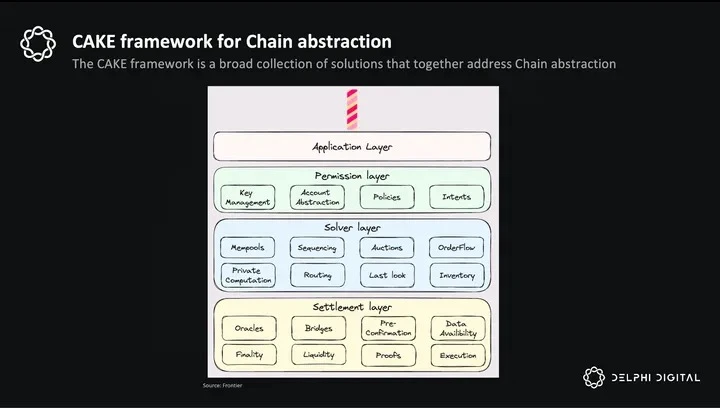
Permission layer: This layer handles accounts and permissions. It includes smart contract wallets and proxy services, and aims to abstract user interactions and maintain a balance between ease of use and user control.
Solver Layer: The second layer focuses on the solver market and competition between them. This layer solves the routing problem by finding the best solution for the user based on their preferences for speed, cost, and efficiency. The solver market competes to provide the best transaction path, enhancing the overall user experience by automating the decision-making process and reducing the cognitive load on users.
Settlement Layer: The final layer is responsible for settlement interactions. It utilizes bridges, oracles, and other cross-chain solutions to ensure transactions are completed efficiently and accurately. This layer abstracts the complexity of cross-chain interactions.
We will compare different solutions in these layers in detail later. ZetaChain is one of the solutions that solves multiple problems.
At a high level, ZetaChain is an L1 based on the Cosmos SDK, using CometBFT as the consensus protocol. Its core value proposition is to deploy full-chain smart contracts and provide a unified application experience. Developers only need to deploy one contract, and ZetaChain will take care of it. Cross-chain interaction. In the following chapters, we will first explore how ZetaChain works and understand its mechanisms. Later, we will discuss the enhancements in version 2.0, focusing on new features and improvements.
ZetaChain Architecture
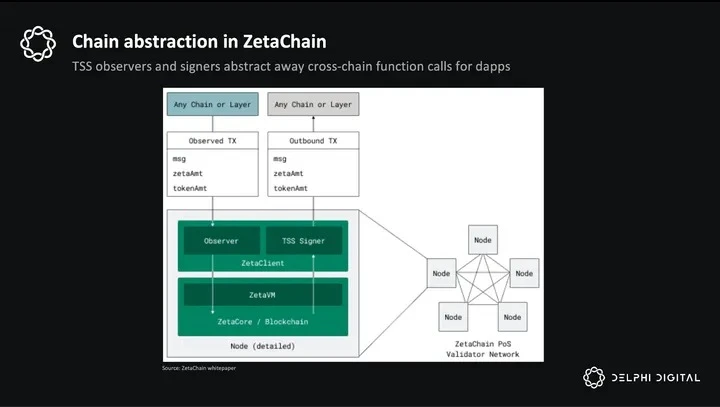
ZetaChain components and their functions:
Universal EVM: An improved Ethereum Virtual Machine (EVM) designed for building full-chain applications.
Communication Mechanism:
Full Chain: An interoperability layer that allows developers to build full chain applications that can be called from connected chains.
Connector API: Point-to-point cross-chain messaging, supporting arbitrary data and value transfer.
ZRC 20: A standard for all-chain fungible tokens. Native gas and supported ERC 20 tokens can be sent from connected chains to all-chain applications as ZRC 20. ZRC 20 tokens can be withdrawn to connected chains.
TSS Signer: A validator with additional responsibilities, including signing and monitoring outbound transactions.
TSS Addresses: Specific addresses used to deposit tokens and initiate cross-chain interactions.
ZetaChain, like Near Protocol and Lit, uses Threshold signatures. The Threshold Signature Scheme (TSS) is a cryptographic method in which a signature is generated collaboratively by a group of participants. It requires a minimum threshold number of participants (e.g., 3 out of 5) to sign a block. A valid signature can only be generated by two or more participants, each of whom holds a share of the private key. This enhances security by distributing private keys among multiple parties, preventing single points of failure, and ensuring fault tolerance.
On ZetaChain, observer-signer validators run two different software:
ZetaChain Node: A blockchain node that handles cross-chain transactions, ZRC 20 minting management, full-chain application calls, etc.
ZetaClient: An off-chain program run by a watcher-signer that observes transactions on a connected blockchain and signs and broadcasts transactions on the connected chain on behalf of ZetaChain.
These TSS signers continuously monitor deposit addresses on all supported chains, ensuring they pass on information on successful transactions, triggering activity on ZetaChain. Additionally, they are responsible for signing outbound transactions, which are dispatched to other chains for processing.
This makes contracts deployed on the Universal EVM not limited to ZetaChain. They can be called from connected chains.
Inbound communication:
Users can interact with DApps built on ZetaChain from any external chain. TSS Observer monitors a special deposit address for native gas tokens and an ERC 20 escrow contract for ERC 20 assets. Create a transaction to this deposit address or ERC 20 escrow contract, The function call information is embedded in it. The TSS observer verifies this content and sends it to the system contract, which calls the OnCrossChainCall function in the corresponding contract to execute it.
Outbound communication:
Contracts on ZetaChain can use the Connector API to call connected chains. The contract calls the Connector contract with details such as the chain ID, contract address, and message. ZetaChain then processes this call and forwards these details to the target chain, where the call The onZetaMessage function of the receiver contract.
These mechanisms ensure that ZetaChain contracts can efficiently respond to and initiate requests from other chains with minimal effort on the part of DApp developers or users.
Inbound and outbound communications between ZetaChain and external chains are triggered by users from their frontends. This means they can interact with a simple frontend without having to understand the underlying mechanisms.
Now that we have understood the basic ZetaChain architecture, let’s turn our attention to the latest iteration – ZetaChain 2.0 and its expanded capabilities.
ZetaChain 2.0
ZetaChain 2.0 is now available and includes several new additions that make the previous experience more complete. It supports a wider range of compatible Bitcoin addresses, replaces the connector API with expanded full-chain functionality, and a simpler user A full-chain account for experience.
The new ability to call contracts on connected chains directly from Universal Applications makes powerful full-chain applications possible. Applications can now handle complex multi-legged transactions involving various assets and interactions across multiple chains, all Reduced to a single user step. For example, a user on Bitcoin can trigger a ZetaChain contract that can seamlessly execute additional contracts on Ethereum, BNB, and other chains.
Universal apps
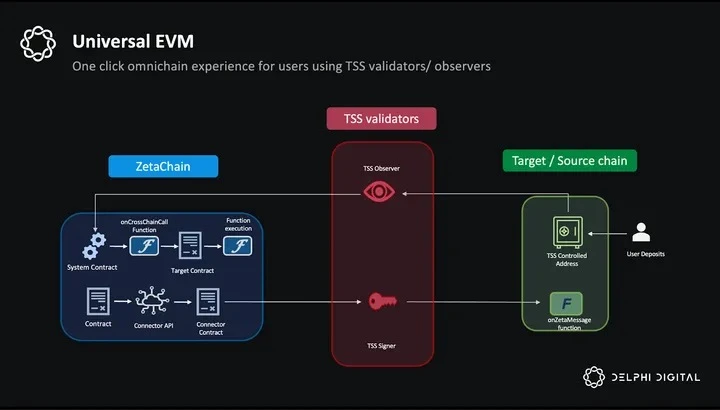
One of the biggest new features in ZetaChain 2.0 is Universal DApp. ZetaChain 1.0 provides two separate features: cross-chain messaging and full-chain applications. Through cross-chain messaging using the Connector API, users can use ZetaChain as a central Relays send arbitrary messages between connected chains. The full-chain functionality allows Universal DApps to accept calls from connected chains and manage homogenous tokens on connected chains.
In ZetaChain 2.0, the connector API is being replaced with expanded full-chain functionality, allowing Universal DApps to call contracts on connected chains. For example, a user can stake BTC, send LST to BNB, exchange LST, and then trade on Polygon. Lending, all done in one interaction. This transforms the application from a full chain to a Universal DApp with multi-leg flows.
In terms of the change in mechanism, the gateway transforms the communication into a hub-and-spoke model, reducing the cost and execution steps. The earlier connector API approach was more like point-to-point communication and introduced more steps, costs, etc. The gateway acts as an entry point for users , and simplifies the interaction.
Here are some details:
ZetaChain 2.0 allows Universal DApps to withdraw ZRC 20 tokens while calling contracts on connected chains through the withdrawAndCall function. Universal DApps can also make contract calls on connected chains without withdrawing tokens.
Deactivating Connector API Instead of providing separate APIs for full-chain and cross-chain messaging, ZetaChain 2.0 provides a consistent and unified set of APIs for building Universal DApps.
Gateway Contracts ZetaChain 2.0 introduces gateway contracts, which act as a single entry point on the chain for developers to interact with Universal DApps. Developers will no longer send native gas assets to TSS addresses, but ERC 20 to escrow contracts. Instead there is a gateway contract that you can interact with.
Allowing ZETA tokens to be staked from contracts ZetaChain 2.0 introduces the ability for smart contracts to stake native ZETA tokens on-chain. This makes it easier for developers to build Universal DApps that are able to stake ZETA in a decentralized manner without the need for Reliance on off-chain procedures.
Modular code structure Earlier versions bundled state transition and message passing logic, making the code complex. The new version separates state transition and message passing logic, simplifying the code base and improving its manageability and maintainability.
Full chain account
Full-chain accounts simplify the way users manage assets on multiple blockchains. The withdrawAndCall feature introduced in ZetaChain 2.0 allows users to withdraw assets and call smart contracts across chains in a single transaction. This feature first ensures the necessary The gas fee is then charged and the specified tokens are burned from the user’s account before further operations are performed on the target chain.
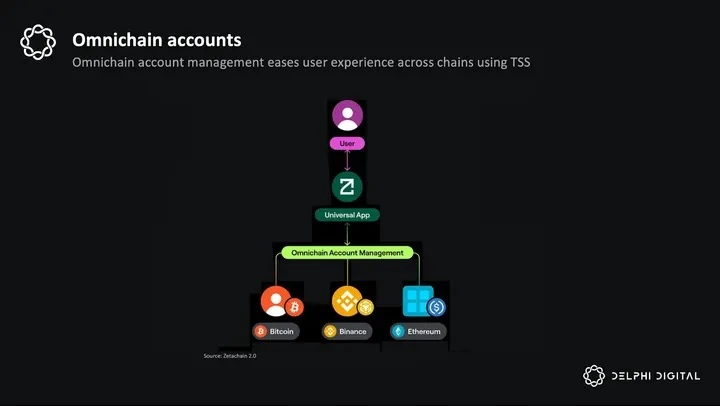
The withdrawAndCall function on ZetaChain simplifies transactions by combining multiple steps into one. It calculates and transfers the gas fees required on both ZetaChain and the target chain. It then securely destroys the specified number of tokens from the users account. An event called WithdrawalAndCall that records the withdrawal and provides the data needed to call the smart contract on the target chain. Finally, the specified action is performed on the target chain.
It reduces the need for multiple steps and network switching, making cross-chain operations simpler. For example, a user using a yield aggregator on ZetaChain can withdraw tokens, send them to another chain, and use them on that chain. All of this is done in one transaction.
The complete BTC experience
ZetaChain 1.0 only supported transactions using specific addresses, which limited interactions. In ZetaChain 2.0, they expanded its compatibility to include a wider range of Bitcoin address types—P2P KH, P 2 SH, P 2 WSH and P 2 TR. This makes it accessible and user-friendly for all transaction types. In addition, with Taproot (P 2 TR) and SegWit-based addresses (P 2 WPKH and P 2 Thanks to the continued support of Bitcoin (BTC), users can now enjoy benefits such as improved privacy, lower transaction fees, and increased transaction efficiency.
Transaction types in BTC
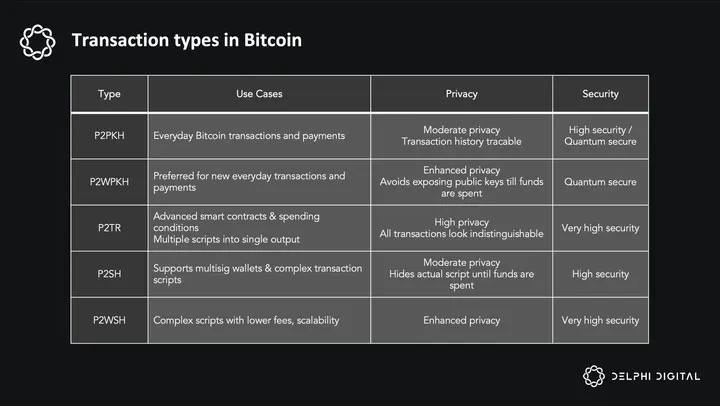
This was achieved through updates in three areas:
1. Address processing
Enhanced decoding: ZetaChain 2.0 has tailored decoding capabilities for recognizing and processing Bitcoin addresses in different formats, such as P2P KH, P 2 SH, P 2 WSH and P 2 TR. These decoding functions are important for identifying each address type, extracting key components such as the public key hash or script hash, and performing thorough validation to ensure accuracy and security.
Support Taproot (P 2 TR): Taproot supports multi-signatures, complex spending conditions, and enhanced privacy. This address type uses unique features such as Schnorr signatures and advanced scripts that are different from the processing capabilities originally equipped on ZetaChain. In order to expand support for Taproot , ZetaChain created a new address type, AddressTaproot. This new design is designed to integrate with existing infrastructure by following the same structure and standards, ensuring compatibility with existing systems.
2. Transaction creation
ZetaChain 2.0 now includes specific scripts for each Bitcoin address type to ensure transactions are P2P compliant KH, P 2 SH, P 2 WSH and P 2 TR addresses have unique requirements. These scripts are critical to defining how transactions are processed, especially to address SegWit-based addresses such as P 2 WSH and P 2 TR) for special requirements for witness data.
3. Transaction analysis
Improved parsing logic to uniformly handle the unique characteristics of P2P KH, P2SH, P2WSH, and P2TR address types. This means the system can correctly identify, extract, and validate the necessary components of each type.
Additional chain support
ZetaChain grows its network by adding new chains through a careful governance process and software updates. This ensures that each new chain is integrated smoothly. Currently, they are considering adding Polygon, Base, Solana, and IBC chains.
Adding new chains may be easier or harder depending on their signature schemes. EVM chains, such as Ethereum, are easier to add due to the wide support of their signature schemes. Other chains may be more challenging. For example, Solana, NEAR Newer chains such as ETH and TON usually use EdDSA (Ed 25519 curve) instead of ECDSA (scep 256 k 1 curve). This usually poses challenges for TSS modules because GG 18 and G The ECDSA TSS in G20 is more mature and more battle-tested than EdDSA TSS. Fortunately, these new chains usually have smart contract capabilities and usually support scep 256k1 operations efficiently at the smart contract level. This makes ZetaChain can use the relatively mature ECDSA TSS technology to connect to these chains.
Additionally, observer validators in the ZetaChain network are required to run nodes for all supported chains. This enables them to verify transactions on different chains.
ZetaChain currently uses its cross-chain messaging protocol and ZetaClient TSS to communicate with other chains. There are also proposals to integrate the IBC module to enhance these communications and expand the coverage of full-chain contracts to Cosmos ecosystem application chains.
Other updates
RPC: ZetaChain is forking the current Ethermint module to extend it and address these issues. Ethermint has been updated to the latest version to support the latest features and security. In addition, we are investigating other issues related to JSON RPC. Customizing Ethermint EVM modules and improved RPC compatibility ensure better handling of cross-chain transactions and zEVM contract interactions.
Throttle mechanism: To protect the network from unwanted or malicious activity, ZetaChain implements an adjustable throttling mechanism. This system dynamically adjusts the transaction rate based on current network conditions and predefined rules. By managing the transaction flow, this The mechanism enhances the stability and security of the network, preventing potential threats such as spam transactions or flash loan attacks. This new addition not only prevents network abuse, but also ensures continued reliability and security for all users.
General Applications on ZetaChain
In ZetaChain 2.0, contracts can be called from external chains, and contracts on external chains can be called. Applications developed using it will generally have a similar general way of working in the background. The first part of an application is to construct a transaction with a function call The details are sent to the full chain contract. This is done by the DApp frontend. This is sent via the TSS observer and forwarded to the corresponding contract on ZetaChain. These are passed to the systemContract which acts as a gatekeeper. This contract ensures that only authorized Functions such as OnCrossChainCall can trigger the subsequent steps of the process, adding an extra layer of security. The OnCrossChainCall function in the target contract processes the incoming message to identify and execute the desired function.
Once this operation is successfully performed, the result is processed and sent to the target chain. The user receives the final result directly in the wallet on the target chain. From the users perspective, this interaction involves simply initiating a transaction on the source chain. and receive the result on the target chain. ZetaChain handles all the complex details of transaction construction, verification, and execution behind the scenes, making cross-chain interactions seem effortless. Users experience a smooth and straightforward process, seeing only the transactions they sign. And the end result, all intermediary steps are efficiently managed by ZetaChain’s infrastructure.
application
Native exchange
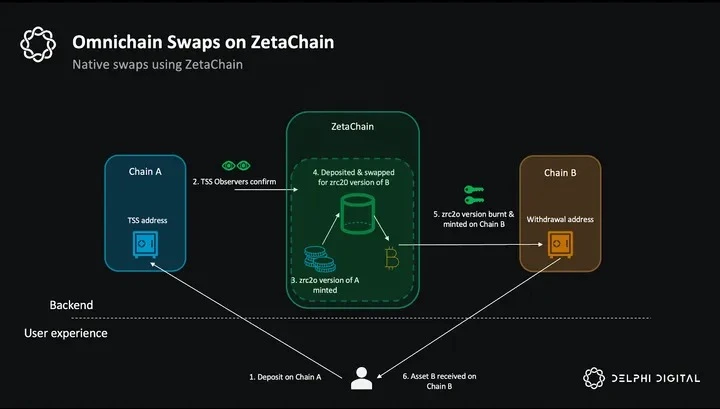
Using ZetaChain, you can implement cross-chain swap applications as Universal contracts. Users first send native gas or supported ERC 20 assets to the Gateway contract on the connected chain, along with the Universal contract address and message (containing the target token and recipient). ). The observer-signer validator observes and processes the transaction. The homogenization module mints ZRC 20 tokens, which represent the tokens deposited into the Gateway contract. The system contract calls the onCrossChainCall function of the Universal contract. This function accepts a ZRC 20 token, The Universal contract then swaps the incoming ZRC 20 tokens for the target using one of the available liquidity pools (the default Uniswap v2 pool or any other DEX contract). ZRC 20 of the token and ZRC 20 of the target chain’s gas token. Finally, the contract calls the ZRC 20 withdrawal method, takes the ZRC 20 gas token (used to pay the gas cost of the destination chain), and withdraws the target ZRC 20 as the native asset to the destination chain.
Staking
The ability to stake ZETA via smart contracts simplifies the development of liquidity staking and re-staking applications on ZetaChain.
In the past, staking applications required off-chain programs that monitored ZETA deposits into smart contracts and staked ZETA on behalf of users. This off-chain mechanism is a source of centralization, making it difficult to build resilient and decentralized staking protocols. becomes more difficult.
With the ability to stake ZETA, contracts can natively accept ZETA tokens from users and other contracts, stake ZETA using the chain’s native staking mechanism (Cosmos SDK staking module), and query the staking module and claim rewards.
Using this feature, Universal DApps can accept tokens from connected chains, provide ZETA tokens and stake them on behalf of users, and earn yield on tokens transferred on the connected chain.
NFT Applications
The ability to natively call smart contracts on connected chains from Universal DApps on ZetaChain makes it possible to create innovative NFT applications. Developers can create applications that accept tokens and messages from connected chains, mint NFTs, and allow users to These NFTs are transferred from ZetaChain to the connected chain and back.
New Applications Enabled by ZetaChain
ZetaChain’s full-chain infrastructure enables DeFi applications to run on multiple chains rather than being limited to a single chain. One of the main advantages of Web3 is its composability, which allows smart contracts to interact and build on each other. Interactions are limited to contracts on the same chain. However, ZetaChain extends this composability to all chains, including those without native smart contract support, such as Bitcoin and Dogecoin. This broadens the scope of what developers can do from all over the world. The range of use cases that benefit from chain abstraction lays the foundation for innovation at the DApp level.
Full-chain treasury management
Fund management across multiple blockchains is a complex task. When an organization’s assets are spread across different chains, each with its own native accounts, the management process is difficult and can lead to Without a unified solution, fund managers must handle multiple accounts, coordinate signatures from stakeholders on various chains, and manually track assets on different networks. This decentralized approach not only increases operational risks, , and limits the ability of finance departments to effectively manage and deploy assets.
By using ZetaChains infrastructure, organizations can have centralized control over their funds while maintaining the decentralized nature of blockchain assets. The key innovation lies in the use of programmable TSS and smart contracts.
Fund managers can write their management logic in a single smart contract deployed on ZetaChain. This contract is the central control point for all financial operations across multiple chains. The initial setup requires stakeholders to provide their keys only once on ZetaChain. This greatly simplifies the approval process.
Once set up, ZetaChain smart contracts can coordinate complex fund operations across different blockchains. This means that assets can be moved, allocated, or used across chains through a single approval process on ZetaChain, without requiring each native chain to Multiple signature iterations of all stakeholders above.
This approach is not limited to sending funds. Funding policies, spending limits, and approval thresholds can be programmed directly into smart contracts so that they are applied consistently across all chains. Additionally, it opens up the possibility for more complex fund management strategies. , such as automatic cross-chain rebalancing or yield optimization, strategies that were previously impractical due to the complexity of managing multiple independent blockchain accounts.
Full-chain portfolio management
Managing a crypto portfolio across multiple chains is difficult, making it difficult for users to balance assets and track the performance of different networks. ZetaChain simplifies this process through a unified, full-chain portfolio management platform.
The full-chain smart contract acts as a central control tower for all user crypto assets and is the key to the solution. This contract uses TSS to interact directly with accounts on various chains. Users can encode investment strategies and rules in the ZetaChain smart contract. Then, The contract uses TSS to execute transactions, move assets, and rebalance portfolios between different blockchains.
Smart contracts can monitor market conditions, automatically rebalance portfolios, and execute complex transactions across chains without human intervention. It does this by generating signatures through TSS, allowing it to securely control assets on multiple chains. .
This approach not only automates cross-chain operations, but also provides a comprehensive view of the performance of the entire portfolio. It opens up the possibility for complex investment strategies such as cross-chain arbitrage or multi-chain yield farming, which were previously impractical.
This is critical to attracting and scaling new users who are interested in the yield opportunity but may not be familiar with the specific steps required for each chain. By abstracting the complexity of multi-chain operations, ZetaChain enables a wider range of users to use Advanced crypto portfolio management.
Native Swapping
We have already discussed native asset exchange applications like ThorChain, where users can deposit and receive assets in their native form. From the user’s perspective, the process is as simple as depositing and receiving funds on a centralized exchange. Since inputs and outputs are simple transfers on the connected chain, this has a significant cost compared to a message-passing based approach where the contract calls involved (message verification, etc.) can be very expensive. All logic is on the full chain Instead of executing the logic one by one on the involved chains, the contract is executed in one place.
Cross-chain lending
ZetaChain 2.0 enhances cross-chain lending by enabling direct function calls from ZetaChain to external chains. This allows cross-chain lending protocols to be deployed on ZetaChain, accepting deposits from lenders on any chain without requiring additional effort from the user. Deposits can include On the borrower side, collateral can be provided in a variety of asset types on multiple chains, creating a flexible lending ecosystem. Looking at the BTC native lending market, there aren’t a lot of options. This opens up new opportunities and markets for builders to realize yield on BTC and borrow against other assets. Developing on ZetaChain also offers more options than ThorChain, allowing Build different architectures with the same input and output tokens.
Re-collateralize assets from any chain
Assets from supported chains can be used to provide resettable security to other chains, similar to the Eigenlayer approach. Resakers can use assets such as BTC, ETH, etc., which may be slashed based on the specific conditions of the target chain or application. This pooled security model allows a chain or application to leverage a diverse portfolio of decentralised assets, thereby enhancing overall security and providing stronger protection for the entire ecosystem.
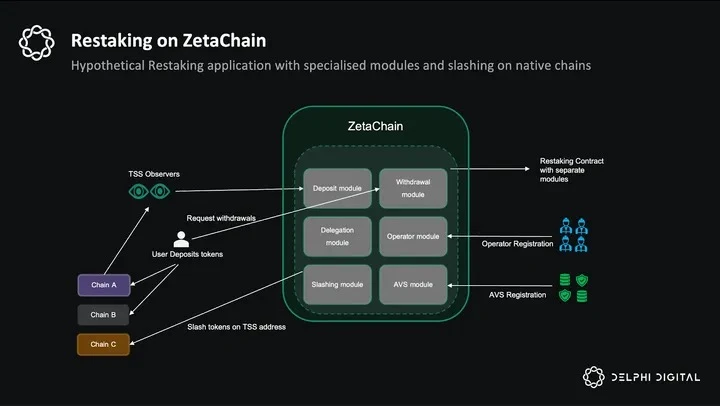
The application will likely be similar to Exocore, where smart contracts on ZetaChain coordinate key functions. These contracts act as modules that can manage different aspects such as AVS registration, tracking stake delegations, processing deposits, processing withdrawals, and performing slashing.
When users interact with the system — whether by depositing tokens for staking or delegating their assets to others — these transactions are recorded by the corresponding smart contracts. This ensures that all user activity is within the ZetaChain ecosystem. are recorded and managed.
TSS signers actively monitor validators to ensure they are loyal. If a validator is malicious or a user initiates a withdrawal, the slashing module responds by slashing the stake on the native chain.
Multi-chain clearing
Assuming that users want to use assets on different chains for lending, it is difficult for users and applications to monitor and manage the liquidation of these assets. It requires continuous monitoring and fast execution across chains to minimize losses to the protocol. With ZetaChain, Assets can be locked in a TSS address and liquidated using an AMM/DEX on the source chain, where liquidity will be large compared to wrapped versions on other chains. This will minimize the amount of liquidity in liquidation, bridging, and The time spent on the asset will be used to take advantage of the better interest rates due to higher local liquidity. TSS observers will continuously monitor these positions and the Universal DApp on ZetaChain will track them. Once the price of an asset reaches the required liquidation If the transaction is successful, the smart contract will trigger it, forward it by the TSS signer and settle it on the native chain.
BTC Application
Ordinals Market, Swap of BTC assets such as BRC 20, lending and other applications are all implemented using ZetaChain. These applications can be combined not only with other applications on ZetaChain, but also with applications on other supported chains. All applications supported by ContractChain are supported, as well as ZetaChain’s full chain functionality for Bitcoin.
Lending between assets such as BTC and ETH will use TSS addresses. The application can be deployed on ZetaChain as a Universal DApp with its underlying logic. If a user wants to borrow ETH with his/her BTC, he/she only needs to deposit BTC into The native chain and signs with their wallet. BTC is locked in the TSS address, waiting for it to be withdrawn or liquidated. The TSS observer records this, mints the ZRC 20 version of ETH on ZetaChain, and sends it on Ethereum. and exchange for ETH directly into the user account. Users simply deposit using their wallet and receive ETH on their ETH wallet. As simple as centralized exchanges. Other applications, such as Ordinals Market, swaps are similar.
Cross-chain orchestration
Chain abstraction is solving a wide range of problems in areas such as account aggregation, resolution, orchestration, settlement, and clearing. We will explore several approaches to solving the orchestration problem and compare them to ZetaChain.
Agoric
Agoric is a JavaScript-based smart contract platform built with the Cosmos SDK and CometBFT. It uses IBC and Axelar to communicate with other Cosmos chains. Agorics goal is to enable millions of JavaScript developers to join Web3. The Agoric Orchestration API abstracts cross-chain The complexity of orchestrating contracts on different chains simplifies the development process.
One of the outstanding features of Agoric is its unique async/await model. This model allows smart contracts deployed on Agoric to interact with other chains, wait for responses, and execute workflows spanning multiple blocks. When messages are sent, they contain instructions (such as account creation or function calls) along with the necessary parameters. Once the target chain processes these instructions and returns the results, the Agoric smart contract proceeds to execute the next steps defined in its logic.
Everclear (formerly Connext)
Everclear , formerly known as Connext , has a bridge that facilitates cross-chain workflows and re-staking from multiple L2s. By integrating the Connext SDK, xApps can send special messages called xcalls across chains. In addition to adapter contracts, these messages Managed by the Connext contracts on the source and target chains to enable cross-chain function calls.
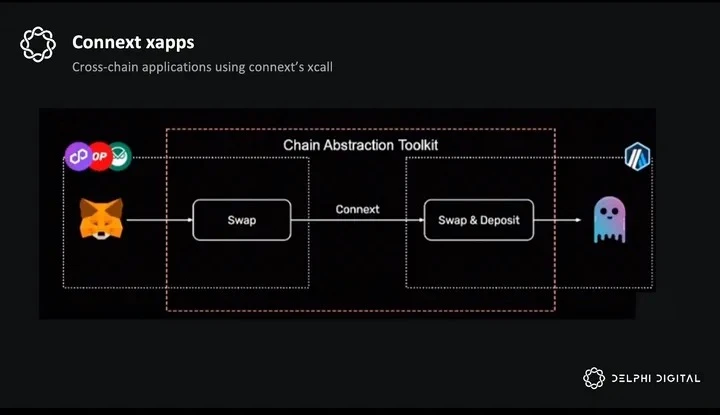
With the Connext SDK, xApps can compile and send xcall messages loaded with all the necessary execution details, such as function calls, funds, gas information, and other data. These messages are initially processed by the Connext contract on the source chain, and then the Connext contract forwards them to its counterpart on the target chain. Here, the adapter contract plays an important role by receiving these messages, converting assets when needed, and executing the specified function with the correct parameters. Connexts system supports nested xCalls, emulating Callback to verify the state change and perform asynchronous follow-up operations.
This allows Connext to effectively act as a bridge, executing contract functions on various chains and supporting complex cross-chain workflows. This is slightly similar to ZetaChain, where function calls are relayed to the target chain and executed.
Comparison between xERC 20 and ZRC 20 tokens
Both ZetaChain and Connext have developed token standards — ZRC 20 and xERC 20, respectively — to facilitate cross-chain applications.
ZRC 20 tokens are an adaptation of the ERC 20 standard on Ethereum, designed specifically for ZetaChain’s cross-chain functionality. ZRC 20 tokens will only be decrypted after the corresponding ERC 20 token is deposited into a TSS address under ZetaChain’s control. Each ERC 20 token from a different chain has a unique representation on ZetaChain; for example, Ethereum’s USDT is displayed as Ethereum’s ZRC 20 USDT, while Binance Smart Chain’s USDT is displayed as BSC’s ZRC 20 USDT. While these represent the same ERC 20 token, on ZetaChain they are treated as different assets but are still exchangeable.
In contrast, xERC 20 tokens remain fungible across different chains. All xERC 20 USDT tokens are treated the same regardless of which chain they come from, helping to consolidate liquidity and avoid the mismatch of ZRC 20 tokens. This fungibility allows for better cross-chain asset management, and xERC 20 tokens are used with xcall messages to send tokens along with function calls and other transaction details.
Particle Network
Particle Network started out by focusing on wallet and account abstraction infrastructure and has successfully met user needs. They have expanded their stack to include chain abstraction, adding key components such as decentralized bundler, paymaster, and keystore on Particle L1. Component to manage cross-chain accounts. This keystore approach is inspired by Vitalik Buterin’s concept of solving the multi-chain account problem.
The Particle abstraction stack covers three areas:
Universal Accounts These accounts upgrade traditional smart contract accounts by integrating a new user operation structure, a master keystore, and a Merkle tree for signature verification. Particle L1 acts as a smart account, handling settings and key-related data A centralized repository for user private keys is created by using a Merkle tree. Users verify key ownership via Merkle membership proofs when initiating transactions. Scroll, Keybase, and Stackr have proposed similar approaches. Keystores are described in detail in the Management section.
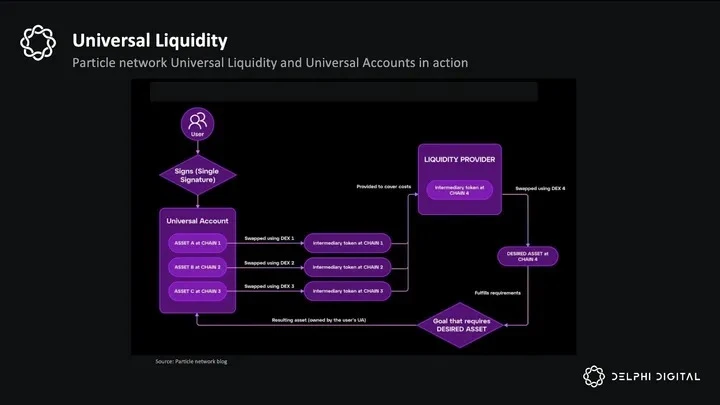
Universal Liquidity: The Bundler node network performs the operations required for user transactions on any chain, such as token swaps and interactions with liquidity providers. This allows users to leverage their token balances on multiple chains, making it easy to User-created operations can interact with multiple chains with a single signature, and Universal Accounts and Bundlers manage transaction construction, signing, and routing.
Universal gas: When a user initiates a transaction, the interface prompts them to select a preferred gas token. This token is then managed through Particle’s Paymaster contract, and gas payments are settled on both the source and target chains. Some fees are charged on Particle L1 Converts to Particles native $PARTI token.
Together, these 3 solutions provide a powerful abstraction experience for end developers and users. Users are able to create cross-chain transactions without having to manage accounts or fuel for the destination. This is all handled for a seamless end-user experience. .
NEAR
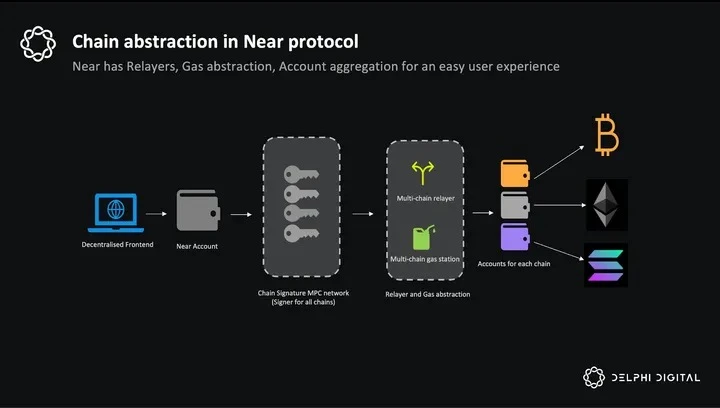
NEAR aims to provide a bridgeless cross-chain experience, unlike other protocols that rely on bridges. It achieves this through chain signatures, multi-chain relayers, and multi-chain gas stations, as well as a decentralized front end.
Account aggregation allows users to sign transactions on any blockchain with a single account, simplifying the user experience. NEAR has developed an MPC protocol called Chain Signatures that uses NEAR and Eigenlayer validators. The protocol generates and Manage accounts without the need for additional keys or addresses. These addresses are derived from existing NEAR accounts. We will take a deeper look at how this works in the “Unified Account Management” section.
Similar to Particle Network, Multichain Gas Station and Multichain Relay simplify the user experience by abstracting gas on an external chain. Therefore, users only interact with the DApp frontend, while orchestration, signing, gas payment, and relaying are handled in the background. conduct.
The main feature of the NEAR approach is the ability to transfer asset ownership between different chains without actually moving the assets. This process starts with creating accounts on other chains using the MPC network, which are linked to the users NEAR account. The ownership of these accounts is encrypted. Instead of wrapping or transferring assets, keys are converted into NFTs on NEAR. Users can then trade these NFTs on NEAR, effectively transferring ownership of assets without moving them.
This approach allows for the high throughput of exchanging native assets using NEAR, as only control keys are exchanged, not the assets themselves.
Neutron
Neutron is built using the CosmosSDK and focuses on seamless cross-chain transactions using several key components. Interchain Accounts (ICA) manage accounts on remote Cosmos chains, allowing them to hold assets and perform transactions. Packet Forwarding Middleware (PFM) Forward IBC packets between chains to make cross-chain communication easier. IBC Hooks allow smart contracts to execute custom logic when receiving IBC packets.
If a user wants to create a cross-chain transaction using Neutron, the Interchain Transaction (ICTX) module acts as the central orchestrator. The smart contract on Neutron sends a request to the ICTX module, specifying the target chain, the interchain account, and the operation to be performed. ICTX then An IBC packet containing the transaction details is created and sent to the target chain via a relay. The remote chain processes the transaction and sends back a confirmation. This method of sending function calls over a bridge is similar to Connext and ZetaChain.
Comparison with ZetaChain
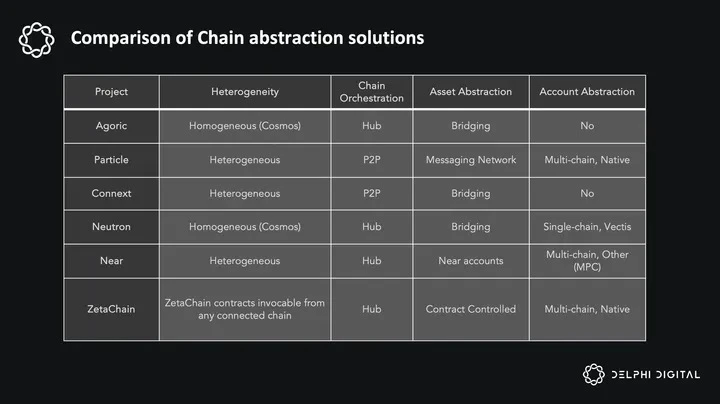
In most approaches, cross-chain orchestration involves a bridge that transfers assets along with corresponding function calls and parameters. These assets and instructions are unpacked on the target chain and executed by the contract. ZetaChain 2.0 also uses this approach. TSS signers and watchers relay data to ensure the security and accuracy of transactions.
ZetaChain allows DApp developers to create smart contracts that can control assets on multiple blockchains using TSS. This makes TSS programmable with the logic of the DApp. Developers can define complex rules for cross-chain asset management and Automated multi-chain transactions. This approach opens up new applications and protocols.
ZetaChain also improves cross-chain applications by allowing developers to build unified state and logic on a single chain. This approach is fundamentally different from traditional bridging solutions, which spread operations across multiple chains. superior.
With ZetaChain, applications keep their entire state and logic in one place, enabling synchronous and atomic execution. This is a significant improvement over peer-to-peer communication systems in bridges, which rely on asynchronous communication across fragmented states. Event driven process.
The benefits of this unified approach are huge. It reduces the complexity of cross-chain applications. For example, implementing an AMM like Curve becomes very simple. Developers can write a single smart contract that handles all the logic in one place. Instead of coordinating complex operations across multiple chains. Another key advantage is reliability. In a fragmented system, each step of a cross-chain transaction introduces a new potential point of failure. This can result in partially completed transactions and loss of funds. ZetaChain eliminates these risks. Transactions are either fully completed or they fail completely and the funds are restored to their original state.
This is because if a transaction needs to be reversed, it can usually be done quickly and easily within the main chain, as most of the state and logic is contained in one place. If the external call is complex and fails, an asynchronous fallback is provided to the application. This is especially important for operations with specific conditions, such as swaps with slippage tolerance. In ZetaChain, if the slippage tolerance is not met, the entire transaction will be rolled back if a rollback function is provided. This protects users from unexpected losses due to changes in market conditions during the execution process.
Unified account management
Block space was once scarce, but is now abundant due to alternate L1s, rollups, and app chains on Ethereum. Applications are now distributed across these layers, providing users with many options. There are some account management solutions , such as Magicspend, Keystore rollups, can directly address these issues. After a thorough study of these issues, it is necessary to write a report of its own. Therefore, we will focus on how unified solutions such as Near, Particle and ZetaChain can solve these problems and the difference.
Particle Network
Particle Network developed BTC Connect to extend the benefits of account abstraction to Bitcoin users. While direct account abstraction is not implemented on Bitcoin L1, it is implemented through L2. These Bitcoin L2s integrate Particles AA infrastructure components. , such as Bundlers and Payment Masters, enabling users to enjoy benefits such as gas-free transactions, account recovery, and keys.
BTC Connect has integrated with different Bitcoin wallet providers, including UniSat, OKX and Bitget. When users interact with the application, they can connect to BTC Connect through their wallet. This connection is automatically created for the user on Bitcoin L2. A Smart Account. Users can then choose to interact with DApps through Bitcoin L1, or bridge their BTC to L2 to take advantage of the benefits of AA Wallet. The entire process is seamlessly abstracted by BTC Connect, providing a smooth and user-friendly experience.
Near
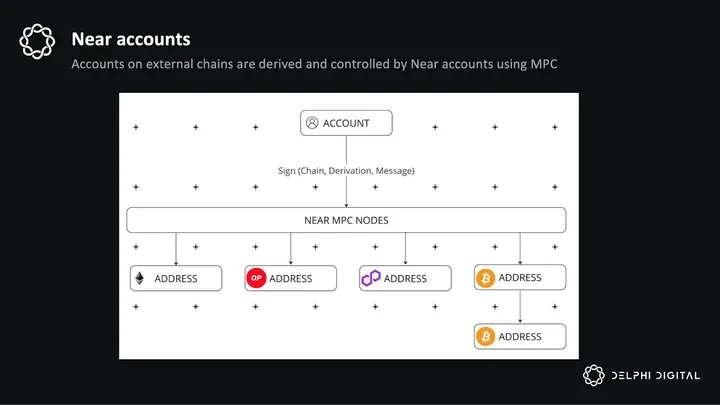
NEAR supports signing transactions across any blockchain using a single account. NEARs account model integrates account abstraction. Users also benefit from human-readable accounts, with different keys for each application. NEAR extends this model to support multi-chain interactions through chain signatures, a protocol that allows NEAR accounts to create and manage remote accounts on other chains without the user having to manage them individually.
This process uses the TSS protocol run by NEAR validators. This innovative TSS protocol allows validators to join and leave the network without changing their public keys or secret key shares, making TSS a stable and reliable signer without frequent changes. Adjustment.
Users can create new accounts on each chain, and the TSS network acts as a signer, without the need for users to maintain the private keys of these accounts. The TSS network can derive multiple accounts for the same chain using different paths through NearID, further enhancing security and ease of use. The end experience for users is a single NEAR account across all connected chains, leveraging all the benefits of TSS for signing and account abstraction.
A key difference in account management is the approach taken by NEAR compared to ZetaChain. NEAR relies heavily on its own network for interaction. When a user wants to create an account or sign a transaction for another chain, their NEAR account will serve as the starting point for all interactions. Accounts on other chains are derived from Near accounts and are managed by the MPC network. In contrast, ZetaChain allows users to maintain their existing accounts on other chains and retain full custody. Users can initiate interactions from any source chain , full-chain applications developed and deployed on ZetaChain can be used without a ZetaChain account. This approach minimizes the need for users to create new accounts, as they can simply use existing accounts on other chains. Important The key benefit is that users retain full custody by holding their own private keys.
Both approaches make different tradeoffs. NEAR’s approach locks in users and serves as the entry point for all chain interactions, simplifying account management to a certain extent. ZetaChain, on the other hand, provides users with more control and Flexibility, allowing interactions from any chain. In the end, it may come down to what users prefer: NEAR’s all-in-one package, or ZetaChain’s flexible bring-your-own-account approach.
Bitcoin Re-staking
Bitcoin is the largest and most secure digital asset, primarily due to its PoW mechanism. However, its limited programmability restricts its use to basic transactions. Previously, we discussed how ZetaChain’s infrastructure supports re-staking and Full chain staking, including Bitcoin. In addition, ZetaChain also supports other full chain applications of Bitcoin assets, such as lending, native exchange, and Ordinal market. Any application using smart contracts can be carried out using Bitcoin on ZetaChain.
Restaking provides an opportunity to leverage the security of BTC for other applications and PoS chains. Let’s explore and compare some other ways to extend the security of BTC to enhance its utility in various applications. ZetaChain as a platform will be compared to Bitcoin L2.
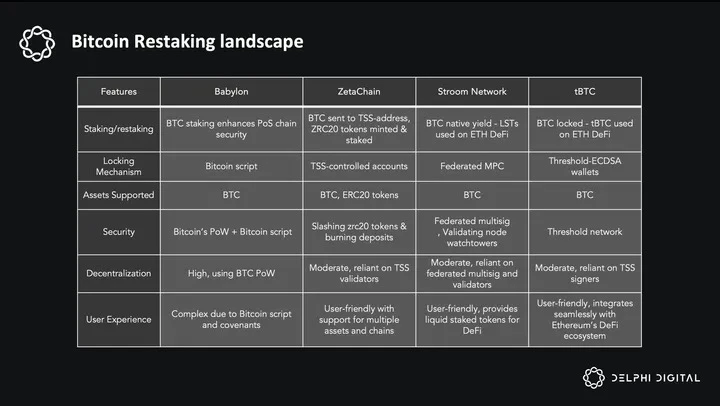
Babylon Chain
Babylon is a CometBFT chain based on Cosmos that improves the security of PoS chains by staking BTC. To stake BTC, it must be locked and controlled based on the behavior of the validator. While Ethereum directly supports this, BTC does not. Typically, BTC is locked in a multi-signature or threshold signature scheme (TSS) account for staking. However, Babylon uses a trustless approach. It uses Bitcoin scripts to lock BTC for a period of time, during which users can unlock and Unlock their BTC. The slash is done using Extractable One-Time Signatures (EOTS).
Components:
Extractable One-Time Signature (EOTS)
Covenants
Timestamp
Covenants: Covenants lock BTC in a vault until certain conditions are met, using Bitcoin script opcodes such as OP_CHECKTEMPLATEVERIFY ( OP_CTV ). Bitcoin’s PoW security ensures that BTC remains safe until these conditions are met.
EOTS: Validators use EOTS to sign blocks of the PoS chain. These signatures are only used once. If a validator signs two conflicting blocks at the same height, EOTS will reveal the validators private key, allowing the protocol to cut BTC. Dishonest behavior is punished and honest verification is encouraged.
Timestamp: Timestamps create an unchangeable record of data or transactions, preventing remote attacks on the PoS chain. This process synchronizes Bitcoin and the PoS chain, ensures data integrity, and speeds up the unbinding of staked BTC. Timestamp Shorten the unbinding time, allowing users to quickly retrieve their assets while preventing remote attacks.
Using these components, Babylon provides a trustless re-staking alternative.
Stroom Network
The Stroom Network allows users to stake their BTC and earn native BTC yields without locking up their funds. Users can also earn liquidity staking tokens that can be used in DeFi protocols on Ethereum to increase yields. The idea is to use BTC to provide liquidity in the Lightning Network, generating fees that are shared between users, DAOs, and node operators.
Stroom Bridge: This bridge connects Bitcoin to EVM-based blockchains. Users deposit BTC into the Stroom DAO vault and receive stBTC or bstBTC on Ethereum. These wrapped tokens can be used on Ethereum’s DeFi protocols. Use it to allow users to obtain additional benefits.
Stroom-Enabled Lightning Network Nodes: These nodes manage Lightning Network channels using users’ BTC deposits. Nodes do not have direct access to BTC; any changes to the channel state require approval from validating nodes. Channel management is controlled by a federated multi-signature setup and Schnorr Signature protection. Validation nodes also act as watchtowers, monitoring Lightning node activities.
Stroom Validator Nodes: These nodes approve actions and keep the protocol secure using the FROST algorithm with Schnorr threshold signatures. They independently verify events, ensuring decentralization and security. They store channel states and revocation keys, and update LN state signatures as needed. As watchtowers managed by the DAO, they monitor Lightning Network channels through an integrated Bitcoin full node.
tBTC
tBTC is a decentralized bridge that allows BTC to be used on Ethereum. It allows users to mint tBTC, an ERC 20 token, by locking BTC in an account controlled by the Threshold Network. The token can then be used on Ethereum. It is used in the DeFi ecosystem of the blockchain to provide more utility for Bitcoin holders.
The bridge randomly selects its operators for each epoch to ensure security. To guarantee the security of Bitcoin deposits, tBTC requires the consent of a majority of operators, typically 51 out of 100 threshold wallets supported by ECDSA. This replaces centralized intermediaries with decentralized cryptographic systems.
To deposit BTC, users use the payment script hash (P 2 SH) or payment witness script hash (P 2 WSH) sends it to one of these wallets. The transaction includes the users Ethereum address. The operator verifies the transaction and mints tBTC on Ethereum, converting Bitcoin into a token compatible with Ethereum.
To redeem tBTC for BTC, users provide a Bitcoin address. The system reduces their tBTC balance and releases an equal amount of Bitcoin to the provided address.
Products built on top of the tBTC bridge include:
Mezo: Mezo creates an economic layer using tBTC. It is a PoS network secured by staking Mezo and tBTC, allowing access to BTC DeFi and other utilities.
Acre: Acre provides a simple BTC-in, BTC-out staking process. Users deposit BTC and receive stBTC, which represents partial ownership of BTC in the Acre vault. This enables users to stake their BTC while maintaining stBTC liquidity. Earn yield. Acre stakes BTC in various L2s for economic security, and validators are rewarded in L2 tokens or BTC. Users can redeem their stBTC on Acre to withdraw rewards or convert back to BTC.
While these methods allow for re-staking, they are designed specifically for this purpose. ZetaChain allows re-staking to be combined with other applications such as lending, exchange, etc. to increase capital efficiency and to take place in a single synchronized environment. Apps can also access the user base of other apps in the ecosystem.
Compared with other Bitcoin L2
Bitcoin L2 enhances the utility of BTC using its MPC-based bridge and wrapped assets. However, ZetaChain uses TSS-controlled addresses on the Bitcoin network to represent ZRC 20 tokens on its chain. Compared to the sharding approach, TSS can be more decentralized because a larger, more distributed set of TSSs provides greater Byzantine fault tolerance.
In addition, ZetaChain’s TSS supports full-chain applications, allowing them to be composed with contracts on other chains. This means that BTC applications on ZetaChain can seamlessly interact with multiple contracts on different chains. In contrast, BTC L2 Provides composability only within its own platform.
While BitVM- and CatVM-based bridges could provide trust-free or trust-minimized alternatives, they are not yet feasible.
Future Outlook on UX and the Role of Zetachain
The future of blockchain user experience will see major improvements driven by infrastructure like ZetaChain. Here’s what to expect from ZetaChain and the role it can play:
Seamless Interaction: The trend is moving towards seamless and intuitive user interaction, where the underlying technology becomes invisible to the end user. ZetaChain’s chain abstraction approach is a major step in this direction, enabling blockchain Interacting with the blockchain is as easy as using any Web2 application.
Unified User Interface: With the ability to natively handle cross-chain interactions, applications can provide a unified interface where users can manage assets, perform transactions, and interact with multiple chains from a single platform. This will greatly improve the overall user experience.
Enhanced Application Ecosystem: As ZetaChain achieves more sophisticated cross-chain functionality, we can expect to see the development of richer and more complex application ecosystems. These ecosystems will provide more integrated and interoperable services, providing Provides users with a comprehensive set of tools and features.
Mainstream Adoption: Simplifying the user experience is key to driving mainstream adoption of blockchain technology. By removing barriers related to complexity and usability, ZetaChain can play an important role in bringing blockchain to a wider range of non-technical users.
Innovative Use Cases: The ability to perform complex operations across multiple blockchains will lead to the emergence of new and innovative use cases. Developers will have the tools to create applications that were previously impossible, driving further innovation in the field.










